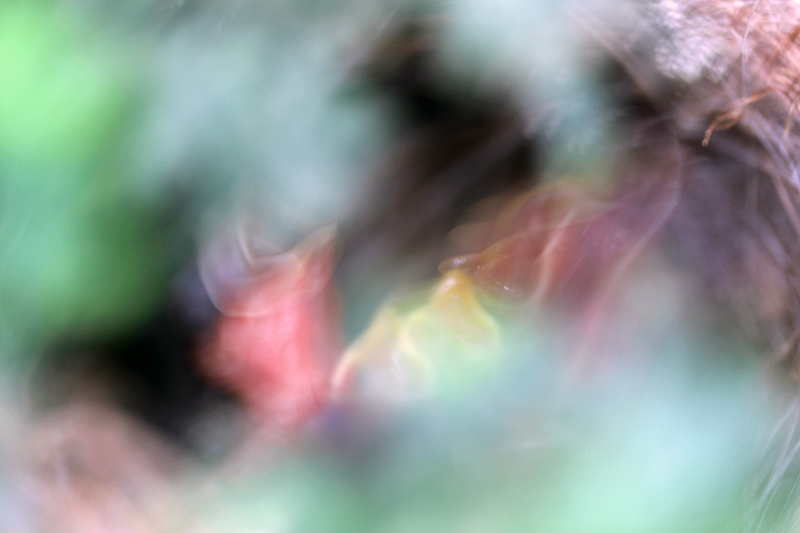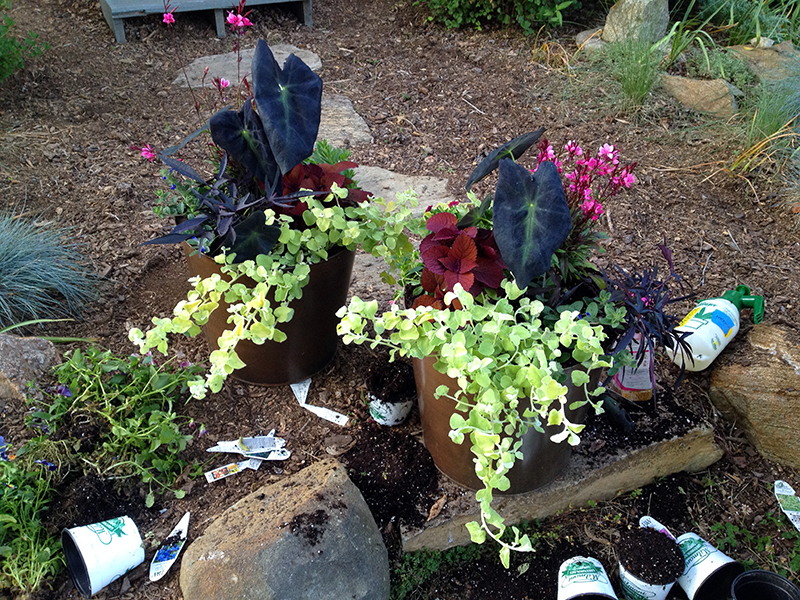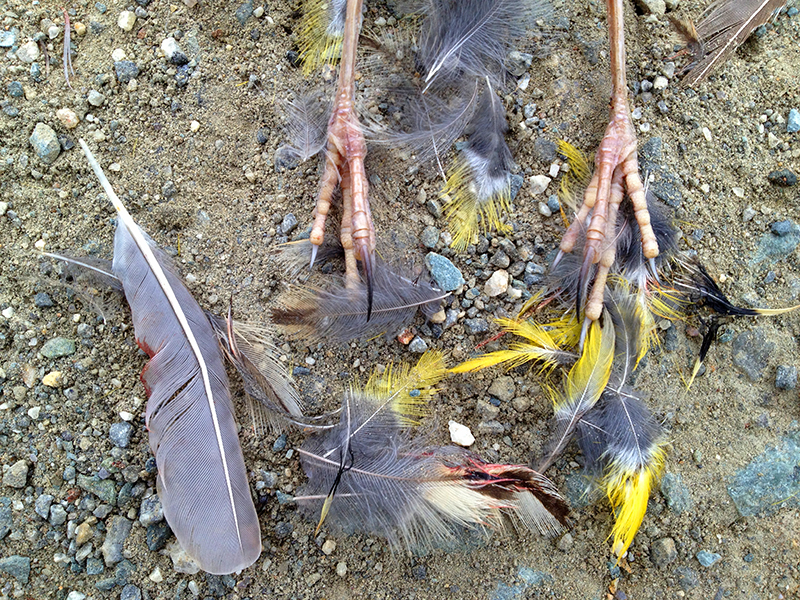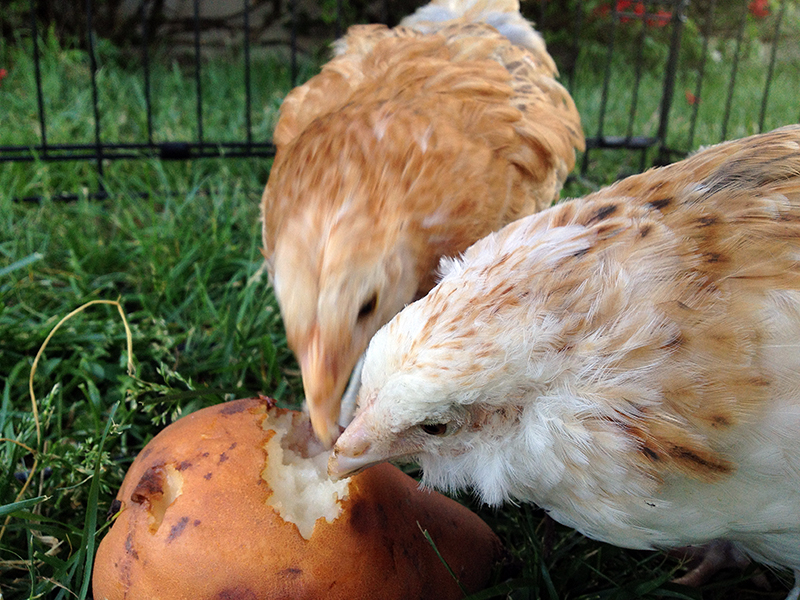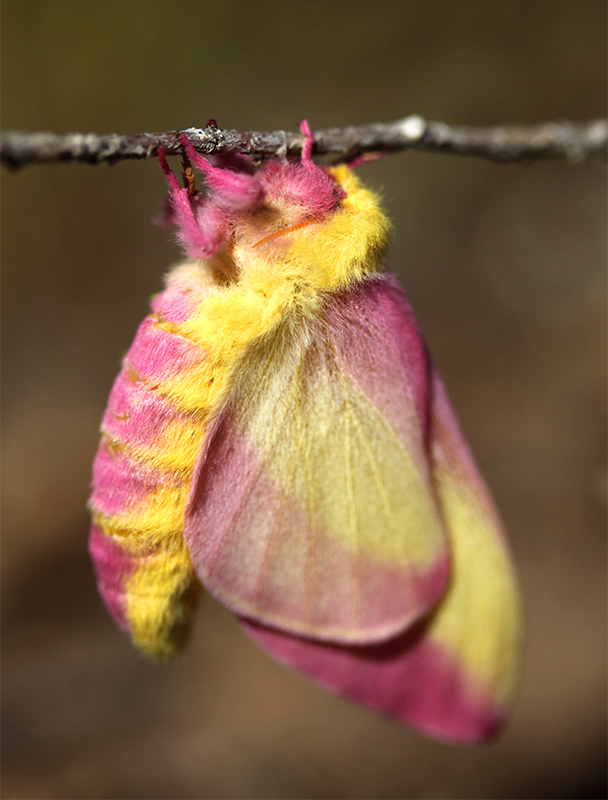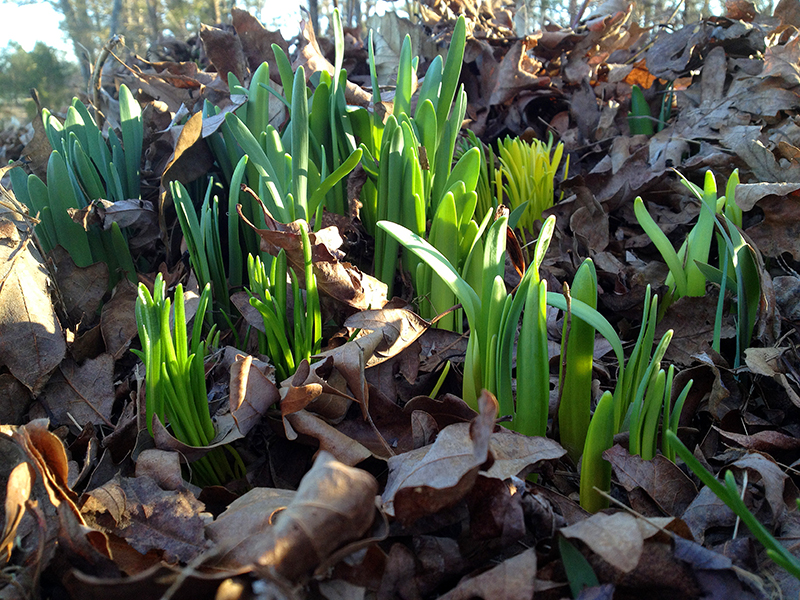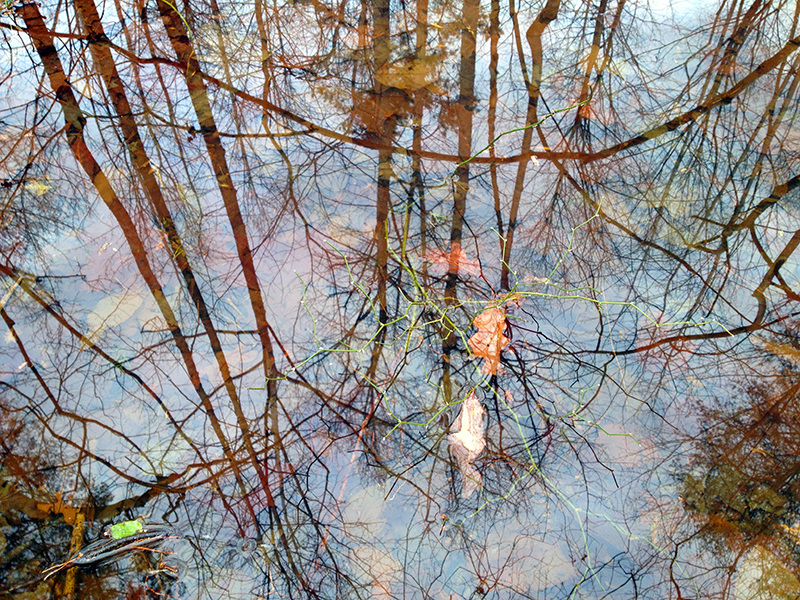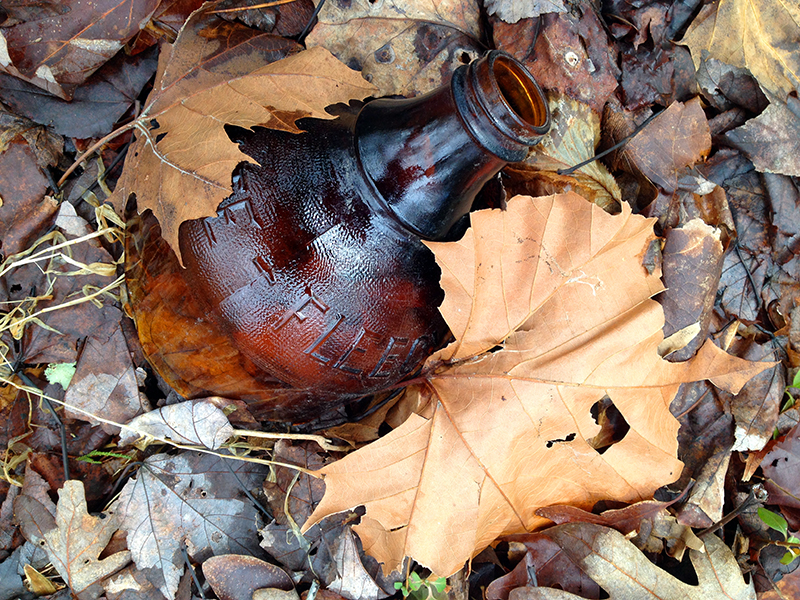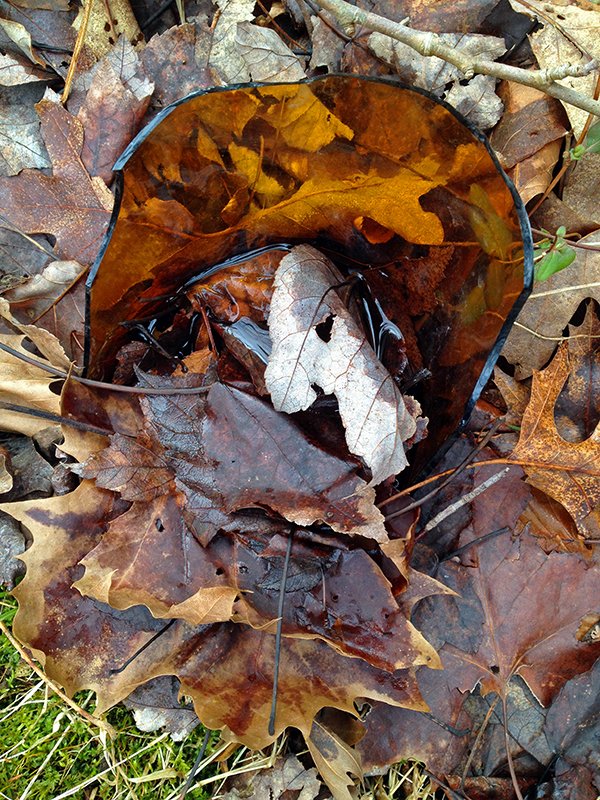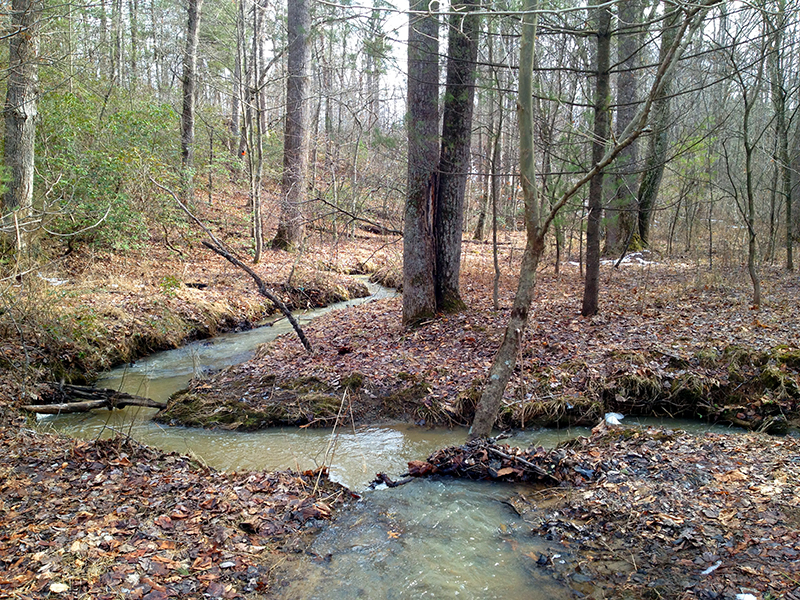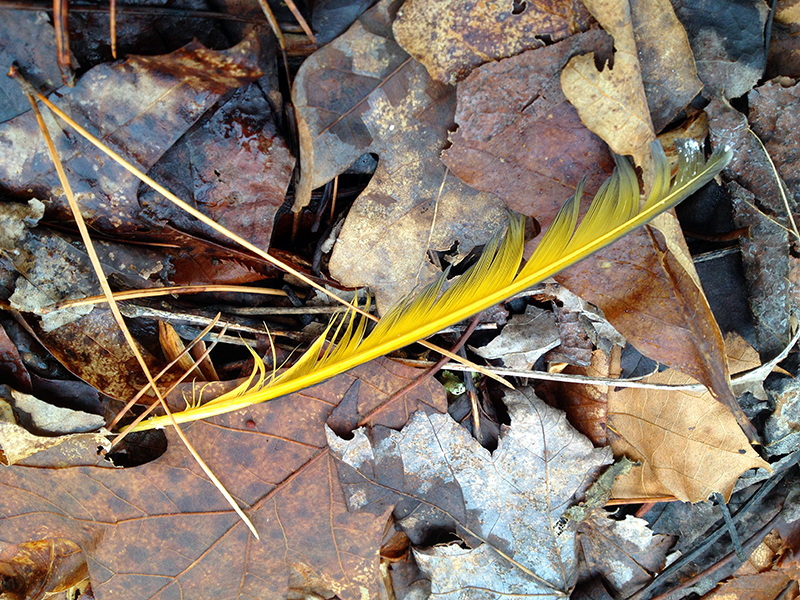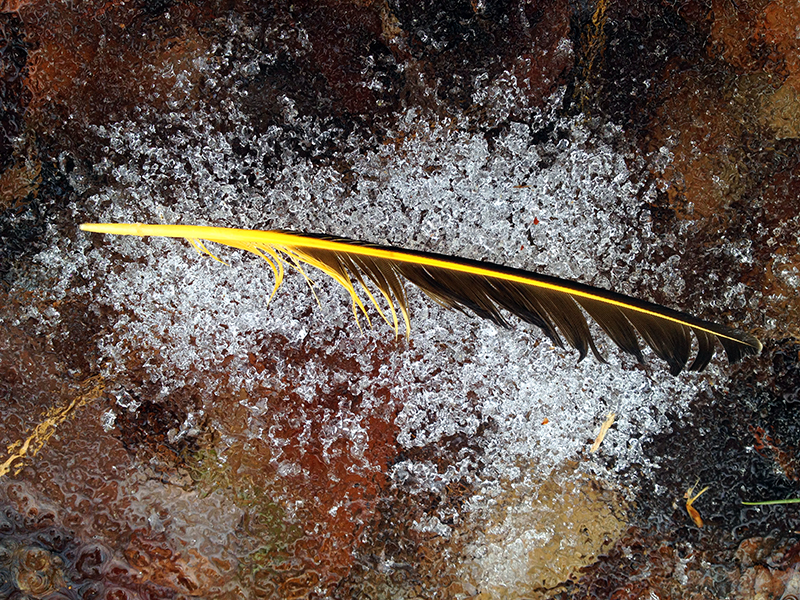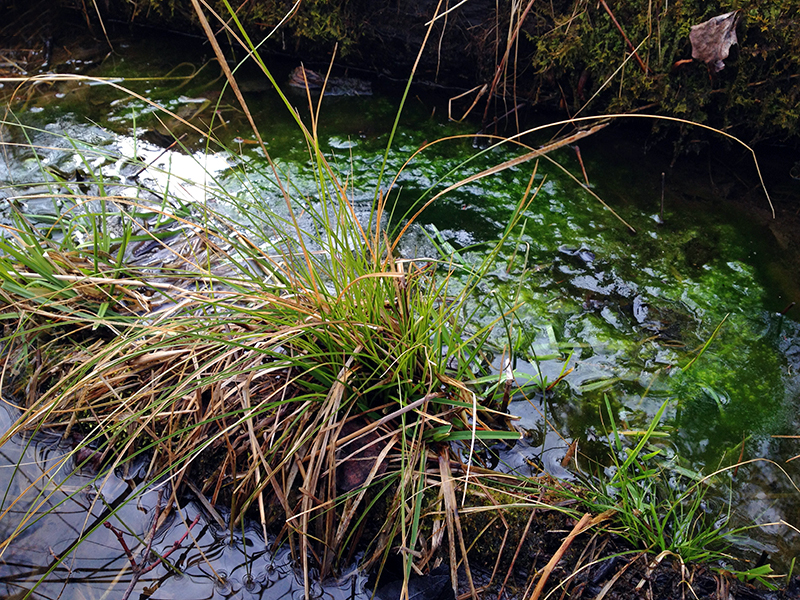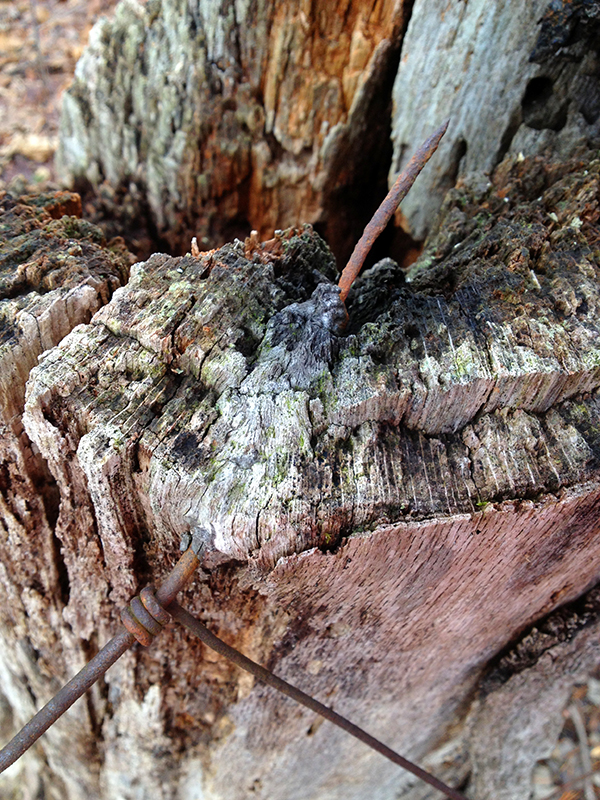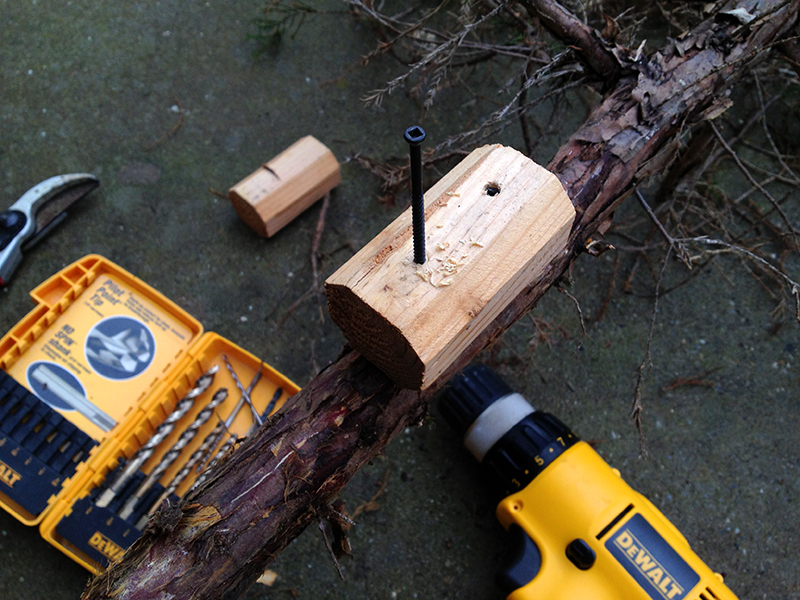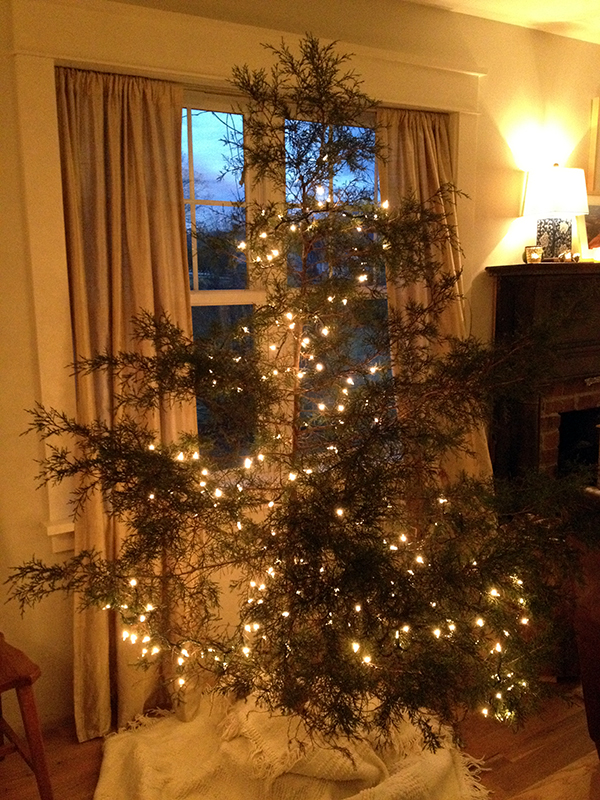Hungry
June 6th, 2014 § 1
Purple martins and potted plants
June 5th, 2014 § 1
It’s finally time for one of my favorite gardening days of the year: redoing the front porch containers. Each spring, after the winter’s pansies poop out from rising temperatures, I get the instant gratification of putting together tiny minigardens to be appreciated up close each time I enter the house.
This year my mom and I discovered a fantastic greenhouse, Milmont, over the mountain in Stuarts Draft. Not only did they have varieties of plants that have been on my wish list for ages, and that I’d resigned myself to having to mail-order, they also had a thriving colony of purple martins living right near their greenhouses. Awesome, rare birds + spectacular, rare plants = pretty much my idea of heaven.
I came home with all the material for this summer’s container gardens and broke down the old arrangements, composting the spent pansies and then refreshing the pots with new soil and granular fertilizer. Then I got down to designing.
This year I wanted high-contrast color, dramatic leaf form, and to play around with some black foliage. To that end, the centerpiece of each container is a black Colocasia ‘Ilustris,’ and that tone is picked up again in black sweet potato vine, ‘Illusion Midnight Lace,’ which will spill over the edges. I always like to add rusty red-pink colors, because they are my favorite and tie into the color of my front door. For that I used Coleus ‘Colorblaze Keystone Kopper.’ I was really drawn to the icy, otherworldly green of Helichrysum petiolare ‘Lemon Licorice,’ to contrast with the black and brighten everything up. For color, I popped in a dwarf Gaura ‘Karalee Petite Pink,’ as well as Calibrachoa ‘Minifamous Double Magenta,’ which has bright pink flowers that look like tiny roses. And for a ringer, I added a shot of pure, bright blue with Evolvulus ‘Blue My Mind.’
The key to good containers, in addition to following the “thriller, spiller, filler” formula, is to stuff in way more plants than you think could fit. Yes, containers planted this fully require more attention with watering and feeding, but you get an instant, lush look. I already know that some of these plant will, if they’re happy, grow too large for these containers, so throughout the summer I will need to keep them trimmed and shaped up to continue looking nice. Not a hard task, and the added bonus is I can root the trimmings and make more plants!
The front porch, all dressed up for summer: the large evergreens below are some form of Chamaecyparis, which I’ve had for more than two years. They are very slow-growing and do okay in pots as long as they don’t dry out, but eventually they will need to be planted out in the yard. I refreshed their soil last year. The plant in the smallest pot is Sedum ‘October Daphne,’ which I cut back each winter for fresh regrowth.
And a purple martin parting shot:
Doing and not doing
May 30th, 2014 § 1
For weeks I’ve been watching a little house wren sit on a tidy nest in a front-garden shrub. I’d found the nest with my spade raised to prise the bush from the ground for relocation. Four blue, brown-speckled eggs popped into view, tucked just inside.
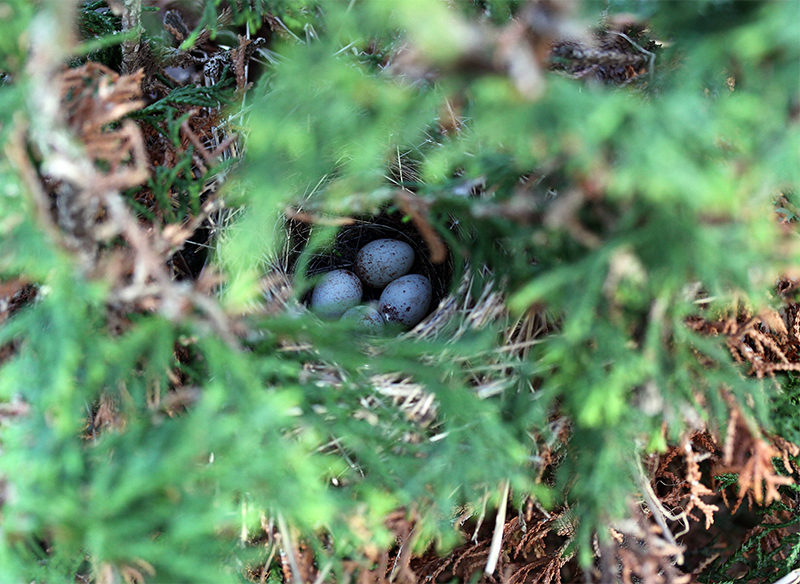
Obviously, landscaping was postponed, and each day I checked on the nest, always expecting the eggs to be gone. They were precariously sited in a bush not two feet off the ground, easy pickings for a snake or raccoon or possum. I considered surrounding the bush with some sort of barrier, but knew that the only thing that would keep a snake out was fine netting. I learned my lesson last summer when a large black snake got stuck and died in the netting I installed to protect the garden from the chickens. So I chose not to intervene with the nest.
Without any “help,” the eggs persisted, and two days ago the mother wren didn’t fly off the nest when I approached. She flattened her body in place, with only her brave eyes moving, and I knew her eggs had hatched.
Yesterday I went out to feed the chickens and saw Tucker bent over something in the grass. I knew that posture. Immediately I checked the nest, and it was empty.
I went back to where Tuck had been standing and searched the dewy clover. I found two little bodies, perfectly bloodless and still warm. I picked them both up, and they curled together in the palm of my hand as they must have in the nest. I almost felt their hearts beating against my skin, but knew it was only wishful thinking. Nearby the mother bird swooped and chattered, scolded and cried.
I buried the babies in a scrape of dirt, and went on with my chores, silent and avoiding eye contact with my dog. Of course I was sad but I had no right to be angry. I knew Tucker was only doing one of his jobs, hunting. A wild baby bird in an ill-positioned nest is to him no different than a rabbit flushed from the wellhouse or mole dug out of the pasture, and all are fair, encouraged game.
As I’d wrapped up the chicken chores I moved some flats of seedlings out of the shed into the rain. I glanced down and saw that my crepe myrtle, still in its gallon nursery pot, had leafed out by several inches from the base.
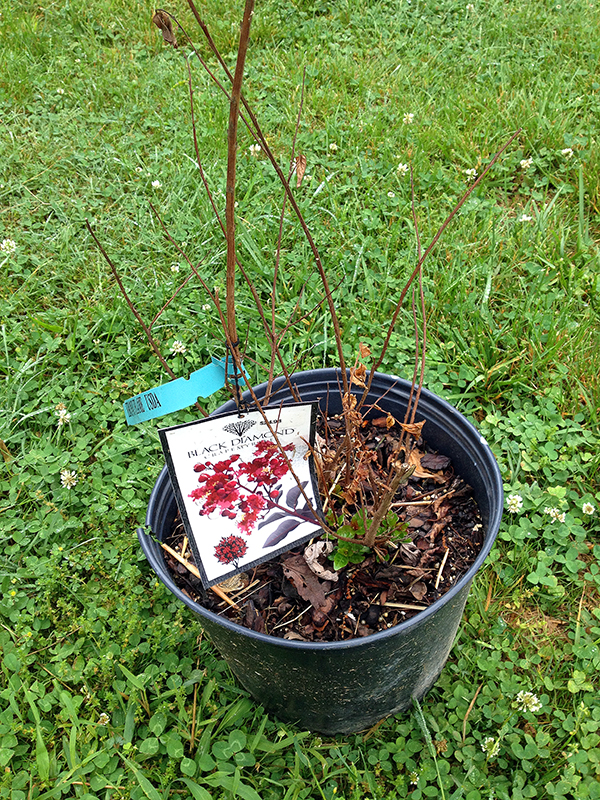
Seems reasonable until I tell you that I’d tortured this plant all last summer, letting it go bone dry and sunburned, as I prevaricated about where in the ground to stick it. And then summer became fall became our incredibly cold and snowy winter, all during which the pot of dead sticks sat unprotected outside of the wellhouse. I was disappointed in myself that I’d killed a perfectly good future tree by not being able to make a simple, timely decision, and just a few days ago I had accepted my crepe myrtle was toast and mentally pitched it on the compost pile.
But in that short interval between intention and action this forsaken plant had quietly, and on its own schedule, conveyed to me its plan to live.
Doing or not doing. Both are choices, and the joke of this choose-your-own-adventure is that we’re all just bumbling along. In a span of five minutes I got a perfect lesson in acting and not acting, and how each movement’s consequences can be both predictable and surprisingly unexpected.
I am going outside now to plant a crepe myrtle.
Still life
May 15th, 2014 § 1
Came across this scene in the middle of a gravel road during yesterday’s walk—a hawk kill? I think this bird’s claws, feet and legs are incredibly elegant.
I can’t figure out what kind of bird it is—its whole body was there, minus the head and innards, and it looked just like a tiny chicken complete with meaty thighs. It seemed much larger than our common songbirds, with a body of about seven or eight inches. It had some slightly barred feathers, which made me think maybe it’s some type of wood pecker? Or a yellow-bellied sapsucker? Any guesses?
State of the bonafide birds
May 12th, 2014 § 0
Last week most of my car trips included a chirping cardboard box riding shotgun. I delivered the chicks, which hatched in March, to their new owners. The little black pullet went to an acquaintance, a Wheaten Ameraucana pullet found a new and loving home with one of my Master Gardener friends, and the four Wheaten Ameraucana cockerels sold on CraigsList within an hour. Isn’t he handsome?
I kept two pullets. One is a pure Wheaten Ameraucana (in front below) and the other is a mystery hatched from a green egg out of a black mother! I love chickens at this age—about ten weeks—because they are sweet and curious, fully feathered but still small enough to pick up with one hand. They’re like little mini chicken pocket pets.
During the day I take the pullets out of their broody coop in the garage and put them in Tucker’s old puppy crate on the grass, and they eat their fill of clover, chickweed, whatever unfortunate bug comes along, and any grubs I unearth while digging in the garden. Last night they got to try pear for the first time.
I am a bit sad that chick season is drawing to a close. If I could, I’d raise chickens all year long. I don’t think I will ever get tired of watching eggs turn into bright-eyed, beautiful birds.
Speaking of which, Mr. and Mrs. Bluebird are busy with their brood of four in the bluebird box. It’s wonderful to be back in bluebird season.
And finally, on a less joyful note, the feisty broody hen that hatched this latest batch of chicks wasn’t feisty enough when I returned her to the main flock. Despite holding her own for two days, on the eve of her third day back I found her with a quarter-size hole torn in the back of her skull. In her pain and panic to get away from her attackers she actually jumped into my arms from the nesting box. It’s the exact same wound Oregano sustained under similar circumstances, though this hen’s is worse.
She’s been getting daily Bactine spray and Neosporin plus Blue-Kote spray (which dyes her wound purple). I wish that I would have stitched her wound when I found it. She keeps knocking it open and it’s taking a very long time to heal, having to close from the outside in across basically her entire skull. In fact it’s larger now than it is in this photo, which I took a couple of weeks ago.
She doesn’t act hurt and has returned to laying eggs. As long as her wound doesn’t get infected I will just keep what I am doing and let it heal itself. My experience with Cora taught me that chickens can recover from the most dramatic wounds. This little hen is protected within another dog crate within the main coop, and will be until she heals and can successfully reintegrate with the flock.
This is what she gets for successfully raising the offspring of her sister flock mates. The injustice!
Beautiful bug: Rosy Maple Moth
May 10th, 2014 § 0
This cotton-candy confection of an insect is Rosy Maple Moth (Dryocampa rubicunda).
I found it, fittingly, on a maple tree in the front yard. Doesn’t even look real, does it?
First blooms of 2014!
March 11th, 2014 § 0
I stepped outside yesterday to see these tiny Iris reticulata had bloomed overnight. It’s amazing what a shock to the eyes a three-inch tall purple plant can be after acclimating to a winter’s color palette of brown, gold and grey.
Even more interesting is that these iris are blooming within days of when they bloomed last year, which I find fascinating because last winter was abnormally warm and this winter has been record-breakingly cold. I would have expected the flowering bulbs to be a bit delayed, but I guess once those longer daylight hours hit there’s no holding them back, whatever the weather.
I am very excited for this spring in the garden. I did a lot of work last spring and summer adding new perennials and moving things around, and last fall I planted a bunch of exciting new bulbs. It’s going to be fun to see how this all comes together this year.
The daffodil and iris planted in the woods are also emerging from their warm blankets of fall leaves. I am really curious to see if the iris actually flower. They’re all from the truckful that my friend Todd donated to the farm last spring. I had way too many to plant around the house so they went rogue and joined the woodland garden.
And tonight I heard the first spring peepers of the year! That is definitely the sound of spring,
Winter colors: Trip to the creek
February 21st, 2014 § 3
When hours in front of the wood stove leave me feeling parched and sleepy, I like to take a walk to my nearest body of wild water. I head down the hill to the creek that runs along the back of my property. I have a relationship with this part of the farm only during winter. From March to about November the brambles grow so thickly that the woods are close to impenetrable, as well as being distressingly thick with ticks.
Walks to the creek in winter remind me of being a kid growing up playing in the woods and streams. Today the mineral smell of standing water and boggy decomposition flung me right back to being ten years old and scooping gelatenous masses of polywog eggs out of still water. The clumps broke apart and slimed my hands as I dropped them into a bucket of water before toting the survivors home to hatch in a fish tank in the garage.
I always find some sort of treasure, usually old broken bottles, mostly of the hootch-holding variety. Today I found an amber jug with the words “white fleece” around its top. Nearby was the bottom of the bottle. I looked online but couldn’t trace the bottle’s provenance. The name make me think of fabric softener—but did that ever come packaged in amber jugs? A mystery for sure.
The sound of the creek relaxes me—some day I’ve love to live near moving fresh water—and I like to walk up the creek in my wellies and feel the current against my feet and legs. Today the water was fast and churning grey from our recent snowmelt and rain.
I have happy memories of the creek being the site of my first adventures with Tucker. When he was a tiny pup we’d walk down there, him absorbing the important lessons of following and staying close to me that have made him such an excellent off-leash trail dog. He’d stop and sniff stumps, memorizing the scents of the native foxes and beginning to understand his territorial responsibilities. I’d coax him up and over fallen trees—massive obstacles to legs just a few inches long—him gaining confidence and learning to trust that I wouldn’t hurt or put him in danger. Trips to the creek laid a good foundation for our partnership.
Eventually I restricted Tuck’s range to within sight of the homestead when I installed his invisible fence. He still has acres to patrol, but his winter visits to the creek are now just memories.
I spotted real treasure today with this small yellow feather. Despite being only about four inches long, against the brown leaves it stood out to me like a beacon. I tucked it into my pocket, to add to my collection, and once home identified it as a wing feather from a northern flicker.
At some point I approached what I was sure was a horse-sized skull buried in the creek gravel. I got very excited, but turns out it was just a plastic bag. Seeing it brought to mind a hike I took up a creek in the Blue Ridge with friends the summer before I went to college. We got to a very tricky part that was basically just scrambling up a sheer rock face covered with rushing water. As I started to climb I slipped and fell backward into a pool of water, hitting my hip and injuring it for for what would turn out to be years to come. I was in great pain, but when I went to heave myself up I turned and saw that I’d splashed down right next to a dead dog, pale and decomposing in the water.
Maybe the winter colors of the creek really are all about death and decay. Regardless, or maybe because of this, I love this winter creek’s color palette best—when the water and leaves combine to give me new appreciation for a subtle layering of browns spiked with an occasional acid green, bone white or flicker gold. It takes work to seek out inspiration in winter, the season of sleeping rot, but each time I walk to the creek I find something beautiful.
A Solstice/Christmas cedar
December 23rd, 2013 § 2
I was out of town during the Solstice last week, and after getting home late last night I felt that my house was missing something related to the season. I hadn’t felt like doing much holiday decorating up until now, but today it was grey and rainy. All I wanted was some light and a reminder that despite it being the official beginning of winter, every living thing around will begin to respond to the now-lengthening days with new growth.
I put on my boots and walked the woods behind my house until I found a little cedar tree that would serve to celebrate both the Solstice and Christmas. I passed by many lusher, more evenly formed saplings, as they were well-positioned to grow into lovely trees. Instead of one of these more perfect specimens I selected a tree growing at the wood line with most of its branches on one side reaching toward the light—fitting for a Solstice tree.

It was growing in the shadow of a nice tulip poplar, and as tulip polars are the main source of nectar for the declining honeybee population around here, I figured I’d eliminate one of the poplar’s competitors. So with a few strokes of the saw, down came the cedar, and I dragged it home across the field.
Along the way I saw a few exquisite things, the first being this snail. After a week in big cities, including Manhattan, marveling at exclusively man-made beauty with nary a natural thing in sight, spying this perfect snail in the damp field almost made me cry with the relief and comfort of being home.
Then I checked up on the deer skull that’s been lying in this same spot ever since I moved here four years ago. The first year it was blazing white among the leaves, but each year the skull gets grayer and more of its nose is eaten off by rodents, giving it an ever more human profile. It’s a memento mori if I ever saw one.
Back home, my scrawny little cedar’s trunk was too small to fit in my Christmas tree stand. I screwed a few blocks of scrap wood to its trunk to pad it out enough to fit the stand.
Then I carried it inside and straightened it as well as one could a tree with a scoliotic trunk.
I tossed two strands of mini lights around the cedar, filled the holder with water, and threw a couple of old wool rugs around the base. My tree is free, free-range, sparse, crooked and lovely. Instead of balsam, it smells like cat pee. But it’s a reminder of light and life during these dark days, and this year it is all that I wanted.
Coyotes
December 13th, 2013 § 3
Just now, at 9:00 at night, I was in my office downstairs on the computer when I heard a pack of coyotes set up a wild commotion right in my front yard. It was so loud that I heard it over my Skype conversation. I jumped up, flipped on all the outside lights, muscled my eager dog away from the front door, and ran into the pasture screaming, “Get the **** out of here! Go away!…” as loud as I could. I made it to the line separating the unmowed pasture from the lawn before the light dropped off and I stopped to listen. I could hear dozens of small feet running through the frosty tall grass. I turned and headed toward the lights of home, this little interaction having set all the neighborhood dogs to barking, and the entire hunt club’s hounds to baying. We all screamed together.
About an hour later my own dog was pacing at the front door, barking. Again I told him to stay inside and stepped out on the porch. Now the pack was back in my woods, where I could hear them singing and pacing. I yelled some more, gave up, and went inside.
In the almost four years that I have lived here, the coyotes have been a remote presence. I used to hear them crying, usually late at night and so far away as to be almost indescernible. But in the last couple of months they’ve moved closer. It started with them waking me up by crying in the field between my nearest neighbor’s house and mine. Then this week they woke me at 12:20 a.m. setting up a racket in the front yard. They were so close that it sounded like they were in my bedroom. I got up and turned on the floodlights to try to scare them away, but really all that happened was that I had a hard time sleeping that night from the adrenaline rush. In my intellectual mind I know that coyotes outside in the middle of the night pose no threat to me or my animals. The dog’s asleep in the laundry room and the chickens are safe in their coop. But there’s something so primally hair-raising about a coyote chorus that I challenge you to peacefully sleep through the sound.
Which brings us to tonight, and a coyote pack that obviously feels comfortable enough to try to claim, at a relatively early hour, my very lawn. I wouldn’t be worried about this but for the fact that when I got my dog, Tucker, from his breeder in Ohio, she told me that in her area coyote packs use their females in heat to lure unneutered male dogs from their yards and then the entire pack kills the dog.
As the caretaker of a dog that is not only unneutered, but that also believes it’s his duty to protect our farm and who runs without hesitation to make his rounds in the dark woods, I am concerned about having Tucker out loose at night when there is a large pack of wild canines very vocally vying for his territory. I always bring Tucker inside at sundown, and he’s let out again for only a moment right before we both go to bed. He always does a perimeter check during this trip, and I listen for him to run through the woods and fields. The entire time he’s outside I am anxious, listening for any sound of a confrontation.
Living in the country is a constant negotiation with all the creatures that called this place home before I, and since moving here I’ve had to assert myself against innumerable insects, snakes, mice, rats, moles, voles, opossums, raccoons, foxes and airborne predators such as hawks and merlins. But the coyotes are a new threat, and the one that most makes me feel as if I’m living in a Jack London novel.
Short of firing a shotgun in their general direction, I am all out of ideas about how to get this pack to choose a territory other than the one my dog and I have already claimed. Does anyone have any other ideas?

